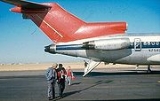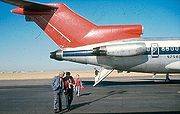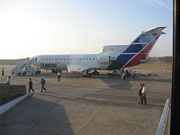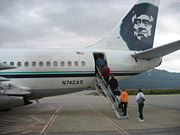
Airstair
Encyclopedia



Airliner
An airliner is a large fixed-wing aircraft for transporting passengers and cargo. Such aircraft are operated by airlines. Although the definition of an airliner can vary from country to country, an airliner is typically defined as an aircraft intended for carrying multiple passengers in commercial...
— often, though not always, on the inside of a clamshell-style door. The stairs can be raised or lowered while the aircraft is on the ground, allowing passengers and ground personnel to board or depart the aircraft without the need for a mobile staircase or a jetway
Jetway
A jet bridge is an enclosed, movable connector which extends from an airport terminal gate to an airplane, allowing passengers to board and disembark without having to go outside...
. Some piston-era airliners were equipped with airstairs, including the Martin 2-0-2
Martin 2-0-2
The Martin 2-0-2 was one of the first modern airliners. The twin-engined piston aircraft was designed and built by the Glenn L. Martin Company.-Design and development:...
, Martin 4-0-4
Martin 4-0-4
|-See also:-Bibliography:* Andrade, John. U.S. Military Aircraft Designations and Serials since 1909. Leicester, UK: Midland Counties Publications, 1979, pp. 95, 217. ISBN 0-904597-22-9....
, and versions of the Douglas DC-3
Douglas DC-3
The Douglas DC-3 is an American fixed-wing propeller-driven aircraft whose speed and range revolutionized air transport in the 1930s and 1940s. Its lasting impact on the airline industry and World War II makes it one of the most significant transport aircraft ever made...
specially modified in the 1940s by Southwest Airways. Airstairs have become less common because of increasing airport infrastructure, but they are still popular on small regional airliners and aircraft which operate into less-well equipped airports.
Due to the height of the doors above the ground, airstairs are almost never incorporated into wide-bodied and long-range aircraft. The only wide-body ever to have the option for a full-height built-in airstair was the Lockheed L-1011
Lockheed L-1011
The Lockheed L-1011 TriStar, commonly referred to as the L-1011 or TriStar, is a medium-to-long range, widebody passenger trijet airliner. It was the third widebody airliner to enter commercial operations, following the Boeing 747 and the McDonnell Douglas DC-10. Between 1968 and 1984, Lockheed...
. The only other wide bodies to feature airstairs (the Ilyushin Il-86
Ilyushin Il-86
The Ilyushin Il-86 is a medium-range wide-body jet airliner. It was the USSR's first wide-body and the world's second four-engined wide-body...
and Boeing VC-25
Boeing VC-25
The Boeing VC-25 is the designation of a United States Air Force passenger transportation aircraft, a military version of the Boeing 747 airliner. The A-model is the only variant of the VC-25....
) use the alternate method of building the airstair into the cargo compartment, and then having more stairs inside to the main deck of the aircraft.
The airplane hijacker D. B. Cooper
D. B. Cooper
D. B. Cooper is the name popularly used to refer to an unidentified man who hijacked a Boeing 727 aircraft in the airspace between Portland, Oregon and Seattle, Washington on November 24, 1971. He extorted $200,000 in ransom and parachuted to an uncertain fate...
escaped via an airstair. Subsequently, Cooper vane
Cooper vane
A Cooper vane is a mechanical aerodynamic wedge that prevents the ventral airstair of an aircraft from being lowered in flight. Following three hijackings in 1972, the Federal Aviation Administration ordered that Boeing 727 aircraft be fitted with Cooper vanes. The device was named for famed...
s were installed to keep the airstair from being deployed in flight. Ventral airstairs incorporated into the Boeing 727
Boeing 727
The Boeing 727 is a mid-size, narrow-body, three-engine, T-tailed commercial jet airliner, manufactured by Boeing. The Boeing 727 first flew in 1963, and for over a decade more were built per year than any other jet airliner. When production ended in 1984 a total of 1,832 aircraft had been produced...
and McDonnell Douglas DC-9
McDonnell Douglas DC-9
The McDonnell Douglas DC-9 is a twin-engine, single-aisle jet airliner. It was first manufactured in 1965 with its maiden flight later that year. The DC-9 was designed for frequent, short flights. The final DC-9 was delivered in October 1982.The DC-9 was followed in subsequent modified forms by...
designs were particularly efficient from a ground handling perspective, for as passengers were deplaning aircraft, cleaners could be servicing the aft lavatories and moving forward, maintaining the aircraft cabin
Aircraft cabin
An aircraft cabin is the section of an aircraft in which passengers travel. At cruising altitudes of modern commercial aircraft the surrounding atmosphere is too thin to breathe without an oxygen mask, so cabins are pressurized at a higher pressure than ambient pressure at altitude.In commercial...
and facilitating more thorough and quicker aircraft turn arounds. Quicker turn around benefits airline, as this allows for greater daily aircraft utilization and thus potentially more profits. Modern airline executive accountants analyze cost benefit penalties of the fractionally increased overall aircraft weight which such designs impose.
Airstairs provide aircraft with a degree of independence from ground services that can be useful in special circumstances. For example, the aircraft used by the President of the United States
Air Force One
Air Force One is the official air traffic control call sign of any United States Air Force aircraft carrying the President of the United States. In common parlance the term refers to those Air Force aircraft whose primary mission is to transport the president; however, any U.S. Air Force aircraft...
are equipped with a full complement of airstairs to ensure that the aircraft can be boarded under any circumstances at any airport, with or without cooperation or presence of ground support.
Design
Ventral airstairs are featured on most tail-engined airliners, such as the Boeing 727Boeing 727
The Boeing 727 is a mid-size, narrow-body, three-engine, T-tailed commercial jet airliner, manufactured by Boeing. The Boeing 727 first flew in 1963, and for over a decade more were built per year than any other jet airliner. When production ended in 1984 a total of 1,832 aircraft had been produced...
, McDonnell Douglas DC-9
McDonnell Douglas DC-9
The McDonnell Douglas DC-9 is a twin-engine, single-aisle jet airliner. It was first manufactured in 1965 with its maiden flight later that year. The DC-9 was designed for frequent, short flights. The final DC-9 was delivered in October 1982.The DC-9 was followed in subsequent modified forms by...
, McDonnell Douglas MD-80, BAC 1-11 and Yakovlev
Yakovlev
The Yak Aircraft Corporation is a Russian aircraft designer and manufacturer...
Yak-40
Yakovlev Yak-40
The Yakovlev Yak-40 is a small, three-engined airliner that is often called the first regional jet transport aircraft...
/Yak-42
Yakovlev Yak-42
The Yakovlev Yak-42 is a 100/120-seat three-engined mid-range passenger jet. It was designed as a replacement for several obsolete Aeroflot jets as a mid-range passenger jet...
series, and are incorporated as ramps which lower from the fuselage. The Ilyushin Il-86
Ilyushin Il-86
The Ilyushin Il-86 is a medium-range wide-body jet airliner. It was the USSR's first wide-body and the world's second four-engined wide-body...
has three airstairs on the port side.
The most common type of airstair is found in most business aircraft, regional jets and other small airliners, which is a stair built into the inside of a door, which is lowered to the outside. This design is efficient and because the aircraft which use it sit low to the ground, the design can stay simple and not add complexity or weight to the design, one of the biggest problems with airstair assemblies. The design has also been used with a single-length set of extension stairs on aircraft such as the cargo compartment of the widebody Ilyushin Il-86
Ilyushin Il-86
The Ilyushin Il-86 is a medium-range wide-body jet airliner. It was the USSR's first wide-body and the world's second four-engined wide-body...
(the primary entrance to the aircraft for passengers), Boeing VC-25
Boeing VC-25
The Boeing VC-25 is the designation of a United States Air Force passenger transportation aircraft, a military version of the Boeing 747 airliner. The A-model is the only variant of the VC-25....
, and the belly lounges of three Lockheed L-1011
Lockheed L-1011
The Lockheed L-1011 TriStar, commonly referred to as the L-1011 or TriStar, is a medium-to-long range, widebody passenger trijet airliner. It was the third widebody airliner to enter commercial operations, following the Boeing 747 and the McDonnell Douglas DC-10. Between 1968 and 1984, Lockheed...
s.
Another widespread type of airstair is used for forward doors. The stair folds and stows under the floor of the door and is deployed from the fuselage immediately below the forward door. This type of airstair is found on many short-range aircraft such as Boeing 737
Boeing 737
The Boeing 737 is a short- to medium-range, twin-engine narrow-body jet airliner. Originally developed as a shorter, lower-cost twin-engine airliner derived from Boeing's 707 and 727, the 737 has developed into a family of nine passenger models with a capacity of 85 to 215 passengers...
s, DC-9s, and some Airbus A320
Airbus A320
The Airbus A320 family is a family of short- to medium-range, narrow-body, commercial passenger jet airliners manufactured by Airbus Industrie.Airbus was originally a consortium of European aerospace companies, and is now fully owned by EADS. Airbus's name has been Airbus SAS since 2001...
series aircraft. The mechanism is also quite heavy; as a result, many airlines have removed this system to reduce aircraft weight.
A unique airstair design was used for the aft doors of 737 Combi aircraft, which consisted of a clamshell door which dropped down to open much like a business aircraft, but then had stairs which were stored trifold in the curve of the door, which would unfold to the ground. This system was very cumbersome, was very susceptible to damage, and thus has been removed by many of its users.
The most unusual airstair design was found on the Lockheed L-1011, which was a full-height airstair which was stored in a cargo compartment and allowed access from the right aft passenger door to the ground. This design was ultimately so large and heavy, and it took up valuable cargo space, that it was rarely used.
The original On-Board Folding Airstairs were designed by Winters Aircraft Engineering Company over 30 years ago. Airweld Incorporated is the current STC holder and has FAA PMA for all of the original STC’s issued to Winters, as well as STC’s issued to subsequent manufactures including Kaiser Aerospace, WAPCO and Advanced Aerospace. The On-Board Folding Airstairs can be found in use on many U.S. and Foreign Military and Government Aircrafts including the Boeing E4B as well as VIP aircrafts around the world. The On-Board Folding Airstairs is a multi-section (3, 4 or 5 segment) airstair that can be installed at either the Forward, Center or Aft doors. When retracted/closed, the airstair sits on a track and is typically stowed in a closet either Forward, Aft or Transverse.
External links
- Period photographs of commercial airliners with lowered airstairs, from the Ed Coates collection:
- Douglas DC-3 of Southwest Airways (second photograph on the page)
- Martin 2-0-2, Martin 4-0-4 of Pacific Air Lines
- The Airstair of Yakovlev Yak-42D Airliners.net

